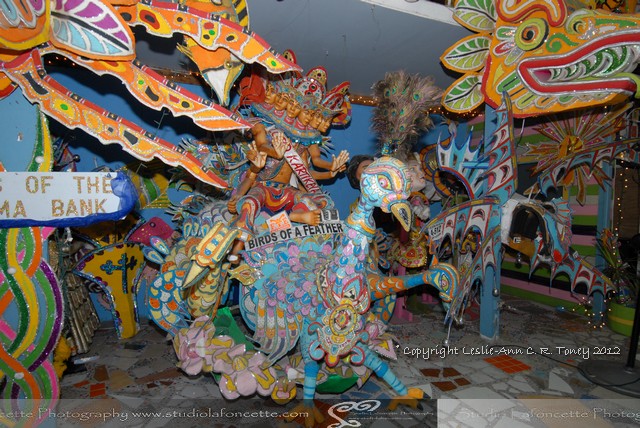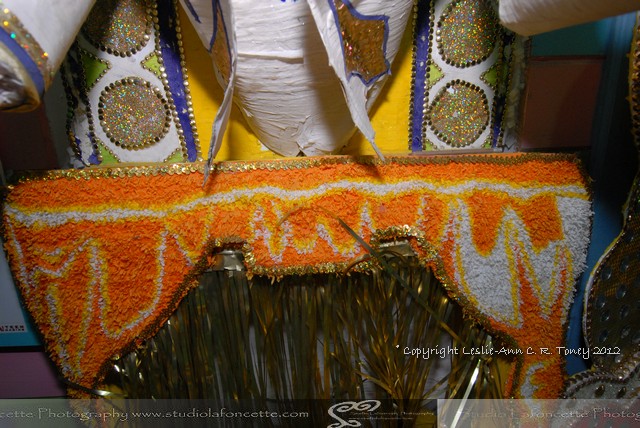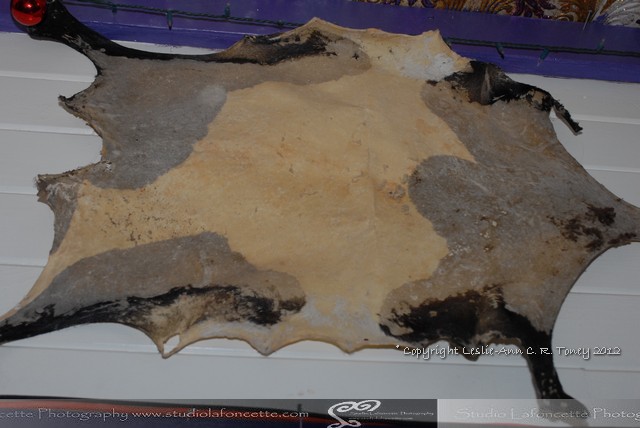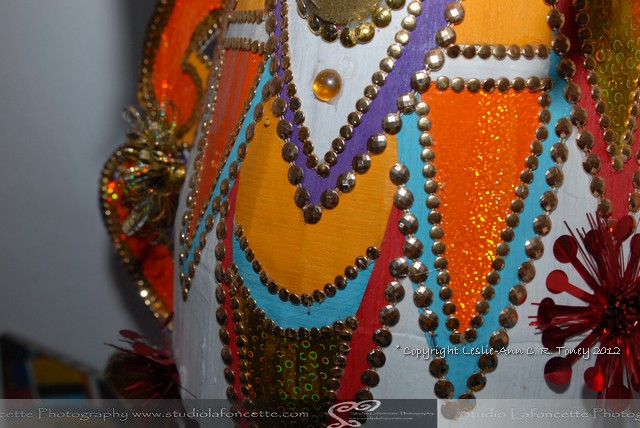I had the amazing opportunity to visit The Bahamas and to get an insider’s view of the Junkanoo shacks* there recently. At this point I’m not at liberty to share much of the photos I took because I agreed to this when I was graciously invited in. However, I can share some things. Today’s lagniappe is about how you do Junkanoo. Let me give the first caveat that I am only just learning and I have so much more to do. But I am exited to share what I know with you as the Bahamians I met were so gracious to share their culture with me.
Fringe detail on one of the costumes on display at Junkanoo World, Nassau, NP, Bahamas
A goat skin hide on display at Junkanoo World, Nassau, NP, Bahamas. The hides cover the big base drums worn by costumed drummers in the troupe who provide musical accompaniment.
Detail on a junkanoo costume at the junkanoo museum in Nassau, NP, Bahamas. The parts shown have a white paint base, the light orange, purple and blue parts are layed strips of crepe paper glued to the base, and then there are embelishments with metalic paper and brass studs.
Junkanoo is the carnival type festival of The Bahamas. It occurs on the day after Christmas – December 26 (Boxing Day) and New Year’s Day. The festival includes large parades of costumed individuals in troupes*. The music is predominantly acoustic – amazing drummers, cow bells, scrapers, brass you name it. Enormous hand made drums and horns are carried on the backs and shoulders as the drummers travel the entire course on foot, in costume. To top it off, all participants who rush* wear these magnificent costumes that are made individually. As I learned from Gary Andrews at the Gaza Boys Junkanoo troupe, the large costumes are made and sponsored by the band. They supply the frames made from welded steel and aluminium, the cardboard and white paint that is the basis of most costumes. Dancers, drummers and section leaders are responsible for hiring individuals who design, cut and mold styrofoam shapes and build out the outer body of a costume and participants work individually to painstakingly decorate costumes with thin strips of crepe paper – sometimes fringed – and feathers. The crepe paper, feathers and other embelishments are glued on by hand in-house at the shacks. Today I give you some photos from Junkanoo World, the junkanoo museum created and run by Quentin “Barabbas” Woodside of Barabbas and the Tribe. More on them later too. In the mean time
Enjoy
L
Terms:
Shack – a warehouse or workshop where junkanoo costumes are made. In Trinidad & Tobago these are called mas camps.
Junkanoo troupe – a group of individuals including musicians and costumed presenters portraying a central theme during the Bahamian festival called Junkanoo. In Trinidad & Tobago this troupe would be called a band. Outsiders tend to use the word float. I have rarely heard that used indigenously and is a bit awkward given that, unlike Brazil, most carnivals and other African festivals do not include floats and mas is predominantly worn on the person (including most samba school participants in Brazil).
To rush – to wear a costume, portray a theme or person and dance or play an instrument in Junkanoo. This is referred to as playing mas in Trinidad & Tobago.




One thought on “BdC Lagniappe 43/52 – How you do Junkanoo in the Bahamas”